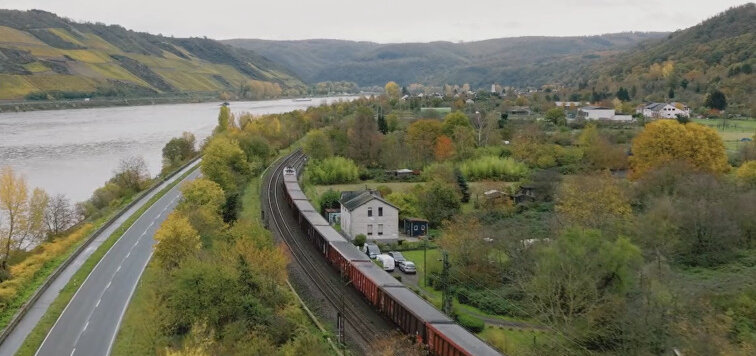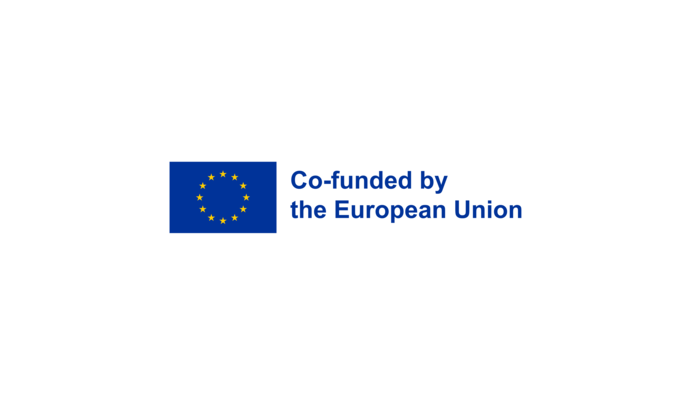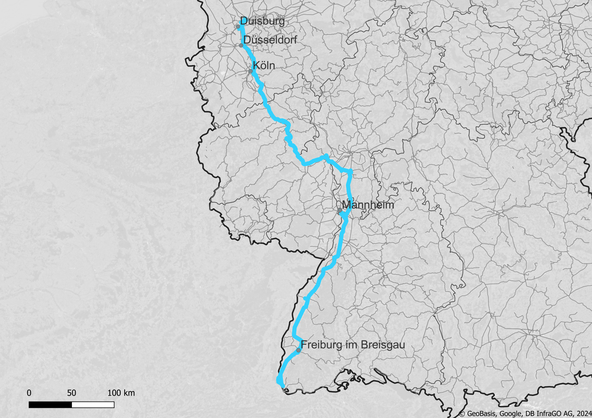
Corridor Rhine-Alpine
As an important north-south axis, the North Sea-Rhine-Mediterranean TEN-T corridor, in accordance with (EU) 2024/1679, links important European seaports and economic areas and is part of the Trans-European Transport Network (TEN-T Corridor Rhine-Alpine until 2024). The Federal Republic of Germany is obliged to equip the German part of the corridor with ETCS by 2040. This is being done in large parts, including in the project Corridor Rhine-Alpine.
Project duration
Route data
| Line from | Oberhausen |
|---|---|
| Line to | Haltingen |
| Kilometers of line to be equipped | ca. 1,362 km |
| Route number(s) | 2183, 2270, 2278, 2281, 2302, 2307, 2315, 2316, 2320, 2321, 2323, 2324, 2326, 2327, 2330, 2331, 2340, 2400, 2404, 2413, 2417, 2418, 2505, 2530, 2531, 2532, 2533, 2535, 2536, 2550, 2580, 2610, 2613, 2614, 2615, 2621, 2624, 2630, 2632, 2640, 2641, 2642, 2643, 2650, 2651, 2652, 2661, 2662, 2663, 2664, 2665, 2666, 2667, 2669, 2670, 2674, 2676, 2690, 2691, 2692, 2693, 2694, 2695, 2730, 3011, 3012, 3014, 3018, 3031,, 3280, 3400, 3401, 3404, 3405, 3410, 3411, 3412, 3505, 3507, 3510, 3511, 3515, 3520, 3522,3525, 3527, 3528, 3530, 3531, 3533, 3550, 3557, 3601, 3603, 3688, 3710, 4000, 4002, 4020, 4021, 4052, 4060, 4061, 4062, 4082, 4210, 4213, 4214, 4260, 4261, 4263, 4280, 4310, 4312, 4313 |
Planned actions
| ETCS | Level 2 with signals, Level 2 without signals |
|---|---|
| Interlocking(s) | approx. 35 |
| Scope of equipment |
|
| Planned speed | 100 - 200 km/h |
Contact
Disclaimer
The dates shown are legally non-binding forecasts based on the current status. The forecasts are in no way intended to establish any kind of legal claim whatsoever that completion will take place by the specified date and that use will be possible. For these reasons, the information should also not be used to make or prepare business decisions, for example, but not conclusively, with regard to the vehicle equipment or the compatibility between the vehicles and the infrastructure. If you have any questions, particularly regarding technical network access or obtaining binding information, please contact your customer advisor.
Most of the infrastructure projects are still in the planning phase, which means that the information provided on these pages reflects the current planning status and is updated regularly.

As an important north-south axis in the Trans-European Transport Network (TEN-T), the North Sea-Rhine-Mediteranean corridor connects important seaports and economic areas between the Netherlands, Belgium, France, Luxembourg, Germany, Switzerland and Italy in accordance with Regulation (EU) 2024/1679. The Federal Republic of Germany is obliged to equip the German section of the North Sea-Rhine-Mediteranean corridor with the standardised European Train Control System (ETCS) by 2040. The equipment concept envisages ETCS Level 2 (ETCS L2). ETCS will facilitate cross-border train journeys in particular. The upgrade is therefore a significant step towards a common and interoperable standard for the European rail network.
The project Corridor Rhine-Alpine comprises most of the equipment on the German section and extends from Oberhausen-Sterkrade to Haltingen near Basel. The equipment affects around 180 operating centres, including important cities such as Duisburg, Cologne, Wiesbaden, Mannheim, Karlsruhe, Offenburg and Freiburg.
Realisation is taking place within the framework of three sub-projects: Subproject West based in Cologne, Subproject Centre based in Frankfurt am Main and Subproject Southwest based in Karlsruhe. In the West sub-project, the area from Oberhausen-Sterkrade to Bad Honnef is being equipped. The Central sub-project is responsible for the section from Unkel to Ladenburg. The south-west sub-project covers the section from Ladenburg to Haltingen. The main tasks of the sub-projects include the construction of new signal boxes, the modernisation and upgrading of existing interlockings, the construction of Radio Block Centres (RBC), the equipping of the line with Radio Block Centre components (installation of balises) and the commissioning of the respective line section.
Commissioning will take place gradually over various route sections and over a period of several years, starting in 2022. Interfaces with neighboring ETCS projects will also be taken into account, such as the ETCS equipment for the routes Belgium – Aachen – Düren, Netherlands – Mönchengladbach – Cologne, Netherlands – Emmerich – Oberhausen or Offenburg – Kehl – France (POS South). Between Karlsruhe and Haltingen, the equipment is being installed in close coordination with the Karlsruhe – Basel new and upgraded line project.
The spatial extent, the high route utilisation and the integration of existing technology make the project Corridor Rhine-Alpine a complex challenge.
Bauende Bahn
This is a Deutsche Bahn project. We are building. So that people can build on us again. More information about the Bauende Bahn can be found here (in German only).

News articles
- Successful start for ETCS on the Rhine
- For a strong European railway: Commissioning of around 60 kilometres of ETCS on the cross-border sections Germany – Switzerland | 15.12.2025
- 100 kilometers of ETCS on the Corridor Rhine-Alpine in practical testing – confirmation train ride with ETCS Level 2 between Freiburg and Basel | 14.08.2025
- Important commissioning on the Corridor Rhine-Alpine: First radio block centre from manufacturer Hitachi Rail in Germany | 11.08.2025
- Innovative thinking: piloting a new type of technology for cable earthworks for control and safety technology and telecommunications measures in Cologne-Mülheim | 10.07.2025
- Commissioning of a modern interlocking system in Cologne-Mülheim - the time has come: Deutsche Bahn's first call-off from an accelerated contract model with the railway industry | 30.06.2025
- Construction work in full swing since March: Deutsche Bahn modernises interlocking technology in the Rhineland | 11.06.2025
- Helicopter deployment in the Black Forest: New signals for modern signal box in Bühl | 23.05.2023, in German only
- First commissioning of ETCS Level 2 on the Rhine-Alpine corridor and in the heavily loaded existing network | 14.12.2022, in German only
- Together for a strong railway: start of the acceptance runs in the "Rhine-Alpine Corridor ETCS major project" with new acceptance locomotive | 07.07.2022, in German only
Press releases
- DB InfraGO puts ETCS into operation on cross-border sections between Germany and Switzerland | 15.12.2025, in German only
- Two in one go: Deutsche Bahn puts electronic interlockings into operation in Baden-Baden and Rastatt | 09.09.2024, in German only
- Rastatt tunnel: Deutsche Bahn builds southern connection to the railway network | 18.07.2024, in German only
- Mouse click instead of keystroke for a strong railway: Deutsche Bahn puts electronic interlocking in Bühl into operation | 13.05.2024, in German only

